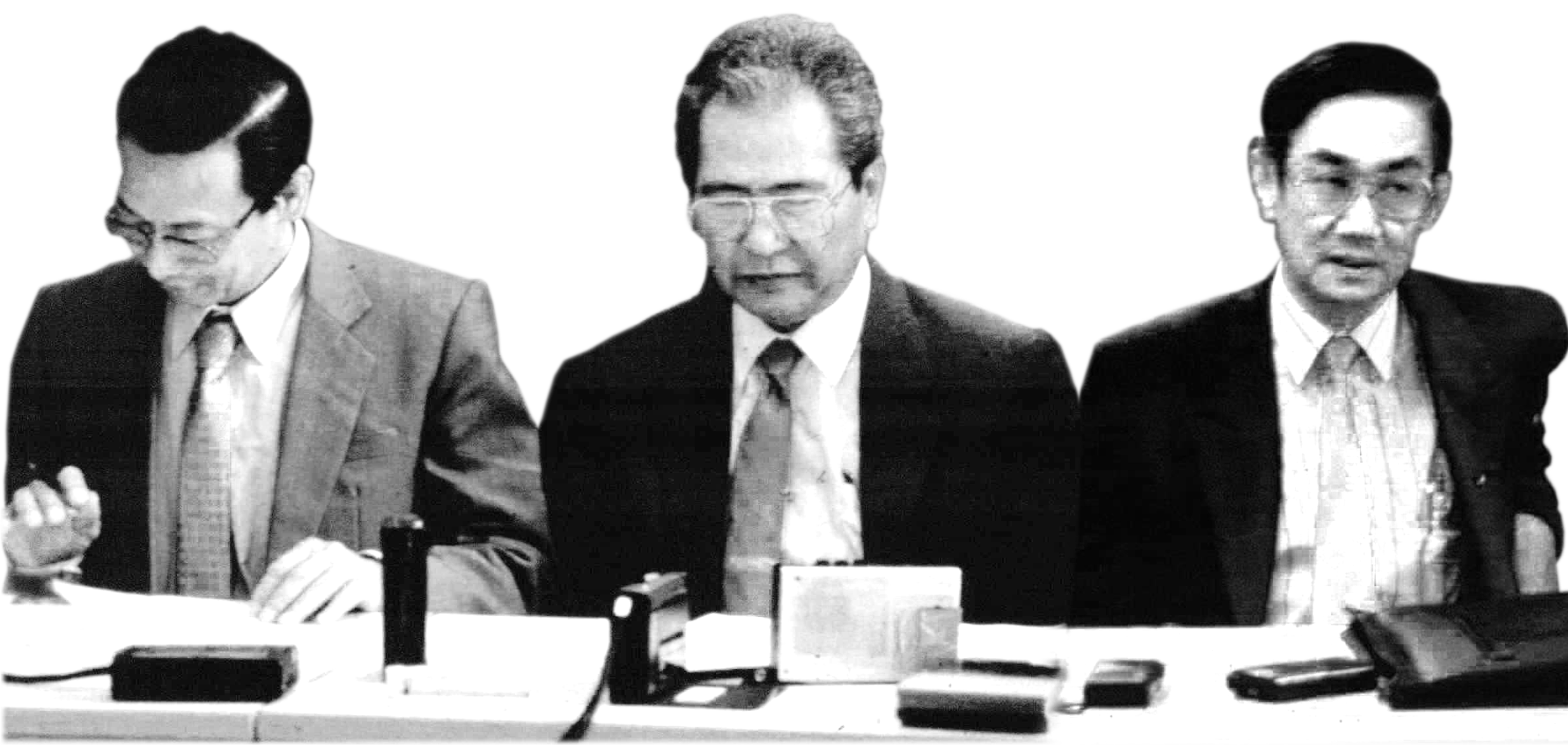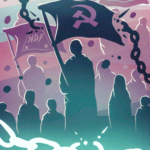The Hague Joint Declaration as Framework Agreement and Continuing Validity in the GRP-NDFP Peace Negotiations
by Prof. Jose Maria Sison
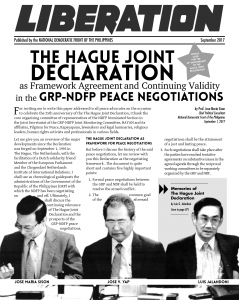
Special Issue for the 25th Anniversary of The Hague Joint Declaration
Chief Political Consultant National Democratic Front of the Philippines September 1, 2017
For inviting me to write this paper addressed to all peace advocates on the occasion to celebrate the 25th anniversary of the The Hague Joint Declaration, I thank the core organizing committee of representatives of the NDFP Nominated Section in the Joint Secretariat of the GRP-NDFP Joint Monitoring Committee, BAYAN and its affiliates, Pilgrims for Peace, Kapayapaan, lawmakers and legal luminaries, religious leaders, human rights activists and professionals in various fields.
Let me give you an overview of the major developments since the Declaration was forged on September 1, 1992 in The Hague, The Netherlands, with the facilitation of a Dutch solidarity friend Member of the European Parliament and the Clingendael Netherlands Institute of International Relations. I shall use as chronological guideposts the administrations of the Government of the Republic of the Philippines (GRP) with which the NDFP has been negotiating on and off. Ultimately, I shall discuss the continuing relevance of The Hague Joint Declaration and the prospects of the GRP-NDFP peace negotiations.
The Hague Joint Declaration as Framework for Peace Negotiations
But before I discuss the history of the said peace negotiations, let me review with you this Declaration as the negotiating framework . The document is quite short and contains five highly important points:
-
Formal peace negotiations between the GRP and NDF shall be held to resolve the armed conflict.
-
The common goal of the aforesaid negotiations shall be the attainment of a just and lasting peace.
-
Such negotiations shall take place after the parties have reached tentative agreements on substantive issues in the agreed agenda through the reciprocal working committees to be separately organized by the GRP and NDF.
-
The holding of peace negotiations must be in accordance with mutually acceptable principles, including national sovereignty, democracy and social justice, and no precondition whatsoever shall be made to negate the inherent character and purpose of the peace negotiations.
-
Preparatory to the formal peace negotiations, we have agreed to recommend the following:
-
Specific measures of goodwill and confidence building to create a favorable climate for peace negotiations; and
-
The substantive agenda of the formal peace negotiations shall include human rights and international humanitarian law; social and economic reforms; political and constitutional reforms; and end of hostilities and disposition of forces
The signatories of the Declaration were Rep Jose V. Yap as emissary of the Government of the Republic of the Philippines and Luis Jalandoni as representative of the National Democratic Front of the Philippines. Witnesses were Eric D. Singson and Teresita de Castro, State Counsel of the GRP, and Coni Ledesma, Byron Bocar and this speaker as Chief Political Consultant of the NDFP. Atty. Romeo T. Capulong, NDFP legal adviser, later NDFP General Counsel, played a key role. He was also a close friend of Rep. Yap. He went back and forth bringing key proposals for the agreement.
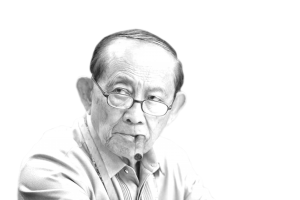
Ramos Administration, 1992-1998
Despite the signing of the The Hague Joint Declaration on September 1, 1992, GRP President Fidel V. Ramos did not form the GRP Negotiating Panel but proceeded to form the National Unification Commission (NUC) with the announced purpose of undertaking local peace negotiations in collaboration with the regional peace and order councils of the GRP. The charade in which military assets posed as commanders of the New People’s Army (NPA) in sessions arranged by the NUC caused a delay for more than two years in the formation of the GRP and NDFP Negotiating Panels, as required by The Hague Joint Declaration. However, BAYAN and peace advocates undertook serious effort in engaging the NUC in the many “consultations” that they held both in Manila and in other regions. Thus, the NUC framework mainly to hold “consultations” with so-called “stakeholders” in order to justify replacing GRP-NDFP negotiations with local peace talks and providing government services and “development” to underserved communities, was sharply exposed and criticized.
Soon after the Ramos administration dissolved the NUC, the GRP and the NDFP Negotiating Panels respectively under the chairmanship of Ambassador Howard Q. Dee and Luis Jalandoni were formed by their respective principals and were able to forge the Ground Rules of Formal Meetings and the Joint Agreement on Safety and Immunity Guarantees (JASIG) in 1994. They were also able to draft the Joint Agreement on the Formation, Sequence and Operationalization of Reciprocal Working Committees for signing and approval by the panels at the formal opening of the GRP-NDFP peace negotiations in 1995 in Brussels, Belgium with the facilitation of the Belgian government.
Immediately after the formal opening, the peace negotiations snagged because of the refusal of the Ramos administration to release from prison the NDFP political consultant Sotero Llamas. After his release, the negotiating panels eventually succeeded in forging the Comprehensive Agreement on Respect for Human Rights and International Humanitarian Law (CARHRIHL) in 1998 in six months of concentrated work by bilateral teams. This is the first item in the substantive agenda of the peace negotiations. Ramos and House Speaker Jose de Venecia expressed the wish that the public signing and approval of the CARHRIHL could be done by the GRP and NDFP principals in Manila if the CPP Founding Chairman and NDFP Chief Political Consultant would attend the event. The wish did not materialize. Ramos finished his term without signing and approving CARHRIHL.
Estrada Administration, 1998-2001
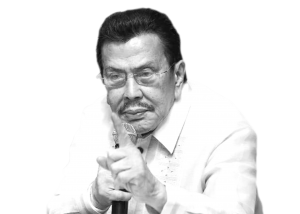
NDFP Chairman Mariano Orosa approAved and signed the CARHRIHL on April 10, 1998, followed by GRP President Joseph Estrada on August 7, 1998. But the peace negotiations never got off the ground because Estrada dilly-dallied in appointing a new GRP Negotiating Panel and took offense at the NPA capturing and holding General Victor Obillo and his aide, Captain Eduardo Montealto as prisoners of war. The NDFP offered their release as a goodwill and confidence-building measure, provided separate but simultaneous and reciprocal ceasefires would be declared for their safe and orderly release. After the Estrada administration refused to issue its own ceasefire declaration, the prisoners of war in the custody of the NPA were turned over to Senator Loren Legarda and other peace advocates.
In 1999, the NDFP admonished Estrada not to sign the Visiting Forces Agreement with the US. He took offense at this once more and formally terminated the peace negotiations with the NDFP on May 31, 1999 by giving a 30-day notice of termination in accordance with the JASIG. As he unleashed war on the Moro Islamic Liberation Front and the Bangsamoro, the NDFP intensified the people’s war and rapidly weakened and isolated the Estrada administration. Estrada’s movie star “popularity ” evaporated quickly. When already in desperation in 2000, he sought to resume the peace negotiations upon the advice of Tarlac Governor Jose V. Yap. But it was too late. The broad united front against his regime was all set to oust him from power in January 2001.
Arroyo Administration, 2001-2010
Vice-President Gloria M. Arroyo took over the presidency upon the overthrow of Estrada by a broad mass movement, including anti-Estrada conservative forces. An international solidarity conference of peace advocates was held in April 2001 in Manila, jointly sponsored by the Joint Peace Committee of the Catholic Bishops Conference of the Philippines (CBCP) and the National Council of Churches in the Philippines (NCCP) and by the GRP and NDFP. There was optimism that the GRP-NDFP peace negotiations would be resumed and would advance faster than before. Former officials of the Ramos administration cooperated with Arroyo. A high intelligence officer of the GRP even agreed to provide evidence for the assassination plot of the Estrada regime against the NDFP Chief Political Consultant. The GRP and NDFP agreed to accept the offer of the Royal Norwegian Government (RNG) to act as third party facilitator.

The GRP and the NDFP negotiating panels reaffirmed the agreements that had been mutually signed and approved since 1992 and resumed the peace negotiations in earnest. However, the negotiations in June 2001 in Oslo, Norway were disrupted when the notorious human rights violator Colonel Rodolfo Aguinaldo resisted arrest and was killed by the New People’s Army in Cagayan, and the GRP side used this incident as pretext for backing out of the peace negotiations. The Arroyo regime “suspended” formal talks from June 14 to September 1, 2001 in violation of the JASIG which does not provide for suspension but only either the continuity or termination of peace negotiations.
Within the last week of November and first week of December 2001, a back channel team of the GRP headed by Speaker de Venecia came to The Netherlands to inform the NDFP that the GRP had requested the US government to put the CPP, NPA and the NDFP chief political consultant in its list of foreign “terrorists” and that the Anti-Money Laundering Council would look into the bank accounts of the CPP, NPA and the NDFP Chief Political Consultant, unless the NPA engaged the AFP in ceasefire and surrender its arms. The NDFP rebuffed the brazen threats but proposed that the peace negotiations could be accelerated without violating The Hague Joint Declaration in order to reach the end of hostilities after agreements on social, economic, political and constitutional reforms.
Executive Secretary Eduardo Ermita (a retired general), Defense Secretary Angelo Reyes (also a retired general) and National Security Adviser; and eventually Defense Secretary Norberto Gonzales, an ultra-reactionary from a pseudo-socialist group, used the Security Cluster of the Arroyo Cabinet to direct the Office of the Presidential Adviser on the Peace Process (OPAPP) and to cause the ouster of less reactionary members of the GRP Negotiating Panel. During and shortly after the presidential elections of 2004, Arroyo sought the support of the NDFP and went through the motions of showing interest in the resumption of formal peace talks. In June 2004, the GRP and NDFP, with the support of the RNG as Third Party Facilitator, agreed to the setting up of the offices of the Joint Secretariat in the Philippines. But the ultra-reactionaries or rabid anti-communists had already taken complete control of the GRP Negotiating Panel and were hell bent on sabotaging the peace process with the demand for NPA surrender and pacification in line with the “counterinsurgency” program Oplan Bantay Laya I and II.
Aquino Administration, 2010-2016
When Benigno Aquino III became GRP President in 2010, he showed no interest in the peace negotiations but in using these as a way of imposing the reactionary state on the NDFP and as a psywar means of the US-designed Oplan Bayanihan. He appointed the ultra-reactionary and rabid anti-communist Teresita Deles as the head of OPAPP. He was late in forming the GRP Negotiating Panel. He seemed compelled to form it only because of the advice of former Sen. Wigberto Tañada and Rep. Erin Tañada. The formal talks during the Aquino II regime was resumed in 2011. At the very outset, Deles attempted to preside over both the GRP and NDFP, but the NDFP rebuffed her.

On the first day of the February 15-21, 2011 talks, GRP Panel Chair Alexander Padilla declared that they were reaffirming The Hague Joint Declaration and other past agreements but with reservation. Then he added that The Hague Joint Declaration was “a document of perpetual division.” The NDFP Panel issued a written response, repudiating the said GRP assertion. The NDFP panel chairperson pointed out that the Declaration had paved the way for twelve major agreements and that it would enable further agreements to reconcile and unite the two sides on reforms needed to address the roots of the armed conflict and lay the ground for a just and lasting peace. The GRP and the NDFP negotiating panels agreed to reaffirm The Hague Joint Declaration and all major agreements to which it had given risen. But with a forked tongue, the GRP panel inserted and included the qualification that the Declaration was a “document of perpetual division.”
Because the GRP always doubted and denied the authenticity of documents of identification issued to NDFP consultants, the NDFP agreed to the examination of the computer discs bearing the identification data of the NDFP consultants in a Dutch bank safety deposit box. The two sides and the third party discovered that the discs had become unreadable because the diskettes with the cipher keys had been damaged as a result of their seizure in a raid by the Dutch intelligence police on the NDFP International Office and residences of NDFP panel members, consultants and staff members.
The GRP side used the discovery to fend off the demand of the NDFP for the reconstitution of its list of consultants who were entitled to the protection of the JASIG and to paralyze the peace negotiations. Attempts were made to use back channel talks with Aquino’s political adviser Ronald Llamas and then with a team headed by Hernani Braganza to overcome the obstacles put up by the Aquino II regime. But these proved futile because the ultra-reactionary Deles and military officers wanted nothing less than the immediate surrender and pacification of the revolutionary forces and people under the guise of a protracted ceasefire.
Duterte Administration, 2016-Present
Before and soon after assuming the GRP presidency, Rodrigo R. Duterte described himself as a socialist wishing to become the first Left president of the Philippines and to negotiate a just and lasting peace with the NDFP and the revolutionary forces of the Bangsamoro. To the NDFP, through Fidel Agcaoili on May 16, 2016, he promised to amnesty and release all the political prisoners listed by the NDFP. On his own initiative, he appointed to his Cabinet four patriotic and progressive individuals who are highly competent, honest and diligent. Everything looked rosy for the resumption of the GRP-NDFP negotiations on the substantive agenda.
But soon enough, Duterte exposed himself as a demagogue and master of deception when in his first State of the Nation Address (SONA) on July 25, 2016, he unilaterally declared in general terms a ceasefire with the NDFP without any prior information in sufficient detail to the NDFP and demanded that the NDFP reciprocate blindly and issue its own ceasefire declaration. It turned out his ceasefire declaration was nothing more than the Suspension of Military Operations Order (SOMO) and Suspension of Police Operations (SOPO), both of which allowed the reactionary military and police forces and their paramilitary auxiliaries to attack the revolutionary forces and people under the pretext of law enforcement and merely continued Aquino’s Oplan Bayanihan until the issuance of Duterte’s own Oplan Kapayapaan.

At any rate, the GRP and the NDFP sides agreed to issue their respective unilateral but reciprocal ceasefire declarations in order to promote the formal rounds of talks. Thus, an unprecedented ceasefire of more than five months ran from August 2016 to February 4, 2017 when Duterte terminated the peace negotiations without even consulting his own negotiating panel on February 20 as previously scheduled and despite the success of the third round of formal talks in Rome on January 19-25, 2017. Under pressure from the Defense Secretary, the National Security Adviser and the AFP Chief of Staff, Duterte demanded a bilateral ceasefire from the NDFP and immediately declared an all-out war policy against the armed revolutionary forces, without ever withdrawing such policy even when the fourth round of formal talks was held in Noordwijk, The Netherlands on April 3-6, 2017.
The insincerity or chicanery of Duterte was first exposed during the first and second rounds of formal talks in Oslo when he backtracked on his promise to amnesty and release all political prisoners in compliance with the CARHRIHL and JASIG. He released only 19 political prisoners on bail and subsequently ordered their rearrest whenever he terminated the peace negotiations or threatened to do so. He has remained adamant that he would not amnesty and release all the political prisoners, unless he first secures the surrender and pacification of the people’s armed revolution under the guise of a protracted and indefinite bilateral ceasefire. He has shown no interest in the acceleration of the peace negotiations to arrive at the Comprehensive Agreement on Social and Economic Reforms (CASER) and the Comprehensive Agreement on Political and Constitutional Reforms (CAPCR) before the Comprehensive Agreement on the End of Hostilities and Disposition of Forces (CAEHDF).
Duterte is surrounded by neoliberal economic advisers and is obsessed with infrastructure building and importing manufactures by auctioning off the natural resources of the country, favoring foreign monopoly capitalism and raising taxes and foreign loans to cover budgetary and trade deficits. He is also surrounded by pro-US military advisers who embolden him to carry out a policy of killing people and bombing communities to suppress the armed revolution and preserve the rotten semicolonial and semifeudal ruling system. The regime has made impossible any substantial allocation of resources for national industrialization and genuine land reform under CASER. The Duterte plan of charter change for federalism ignores the forging of the CAPCR, which is necessary to prevent a pseudo-federal system of regional and provincial warlords under the highly centralized unitary presidential tyranny of Duterte.
Current Circumstances of Impasse Caused by Duterte Regime
Duterte has “terminated” the peace negotiations thrice. The first one was on February 4, 2017 in conjunction with the issuance of his all-out war policy against the revolutionary forces and the people. It was followed up by a “formal” termination of the peace negotiations in a letter to the NDFP Negotiating Panel from OPAPP Secretary Dureza. Through the NDFP Chief Political Consultant, the NDFP patiently reminded and prevailed upon the OPAPP secretary that it I would be better to talk and that teams of the GRP and the NDFP negotiating panels could meet for back channel talks. Thus, the teams met in Utrecht and agreed on March 11, 2017 that the GRP and NDFP engage in discussions for reciprocal unilateral ceasefire declarations be held before the fourth round of formal talks. But the GRP backed out of such a ceasefire agreement and insisted on a prolonged and indefinite bilateral ceasefire agreement ahead of negotiations on the reforms required by The Hague Joint Declaration. Even then, the fourth round of formal talks proceeded and the two sides agreed among others to work out an interim joint ceasefire agreement in conjunction with the signing and approval of CASER and the release of all political prisoners.
 The second instance Duterte declared to the press the termination of peace negotiations was without a formal notice of termination. The “termination” was made in connection with the Duterte regime´s cancellation of the 5th round of formal talks and its complaint that the CPP had ordered the NPA to intensify tactical offensives against the May 23 proclamation of martial law Mindanao-wide, which targeted not only the Maute and Abu Sayyaf groups in Marawi but also the revolutionary forces and people outside Bangsamoro areas. The NDFP pointed out that it was in fact the aggrieved party because the Duterte regime never withdrew its all-out war policy under Oplan Bayanihan of the Aquino regime and then Oplan Kapayapaan of the Duterte regime. And the all-out war policy was aggravated by the Mindanao-wide martial rule and the repeated threats to extend this nation wide. In the absence of any formal notice of termination, the NDFP consultants on bail who were stranded in The Netherlands were able to return home upon the facilitation of the RNG and on the assumption that the peace negotiations were still ongoing.
The second instance Duterte declared to the press the termination of peace negotiations was without a formal notice of termination. The “termination” was made in connection with the Duterte regime´s cancellation of the 5th round of formal talks and its complaint that the CPP had ordered the NPA to intensify tactical offensives against the May 23 proclamation of martial law Mindanao-wide, which targeted not only the Maute and Abu Sayyaf groups in Marawi but also the revolutionary forces and people outside Bangsamoro areas. The NDFP pointed out that it was in fact the aggrieved party because the Duterte regime never withdrew its all-out war policy under Oplan Bayanihan of the Aquino regime and then Oplan Kapayapaan of the Duterte regime. And the all-out war policy was aggravated by the Mindanao-wide martial rule and the repeated threats to extend this nation wide. In the absence of any formal notice of termination, the NDFP consultants on bail who were stranded in The Netherlands were able to return home upon the facilitation of the RNG and on the assumption that the peace negotiations were still ongoing.
The third instance Duterte declared again to the press the termination of the peace negotiations was on July 19, 2017 immediately after the Arakan incident in which two vans of the Presidential Security Group ran into an NPA checkpoint. He also stopped the GRP negotiating panel from meeting with its NDFP counterpart for back channel talks on July 21-23 to prepare the fifth round of formal talks. He made it appear later that the NPA had tried to ambush him. In fact, he was responsible for failing to avail of a longstanding mechanism by which he could have arranged his safe passage with officials of the people’s revolutionary government in their territory. Further investigation showed that the most important passenger in one of the vans was not Duterte but a girlfriend of his.
Duterte and his partisans are making it appear that the NDFP is simply against an interim bilateral or joint ceasefire. In fact, the NDFP considers such a ceasefire possible after the GRP complies with CARHRIHL by an amnesty and release of all the political prisoners; and after the CASER is duly signed and approved by the respective principals of the GRP and the NDFP. In this regard, the NDFP has exercised flexibility without violating The Hague Joint Declaration and the Joint Agreement on the Formation, Sequence and Operationalization of the Reciprocal Working Committees. The NDFP has always made clear that short of any agreement to form a single national unity government under the CAPCR the people’s democratic government exercises all its governmental functions among the people in its territory. In the current civil war in the Philippines, the revolutionary government and the reactionary government confront and fight each other as co-belligerents.
Continuing Relevance of the Declaration and Prospects of Peace
The Hague Joint Declaration has continuing relevance. The five points therein are still needed to guide the peace negotiations. They give the two negotiating sides ample space to negotiate and make mutually satisfactory agreements for the benefit of the Filipino people. The root causes of the civil war that need to be addressed have persisted since the signing of the Declaration in 1992. The reactionary ruling system of big compradors and landlords under US hegemony continues to exist but is confronted by an ever worsening social and political crises and the rise of the revolutionary forces, including the party of the proletariat, the people’s army, the mass organizations, the organs of political power and the alliances.
Whenever any reactionary administration of the GRP is willing to engage in peace negotiations with the NDFP or refuses to do so, the NDFP and the revolutionary forces and people that it represents have no choice but to continue further strengthening the revolutionary party of the proletariat, the people’s army, the mass organizations, the local organs of political power and the alliances. Those who oppose the armed revolution of the people assume the perpetuity of the reactionary state and ignore the growing strength and scope of the people’s democratic government of workers and peasants, which is fighting the reactionary government of big compradors and landlords.
Right now, the balance of forces is such that the possible outcome of the negotiations for a just and lasting peace can only consist of social, economic, political and constitutional reforms that are mutually agreed upon by the GRP and NDFP. The mutually satisfactory agreements can raise the level of national independence, democracy, and economic development through national industrialization and genuine land reform, social justice, expansion of social services, a patriotic, scientific and mass culture and education, national self defense and independent foreign policy. They satisfy the demands of the people now and open the way to a still higher level of development.
Even if the GRP-NDFP peace negotiations cannot succeed at this time, the revolutionary forces and the people will keep increasing their strength by all means, especially people’s war. There is still the possibility that a better negotiating counterpart less reactionary than the current one can arise or the crisis of the ruling system becomes so aggravated that it produces a government that is more ready to come to agreement with the NDFP and the people’s democratic government. But of course, the best circumstances for the peace negotiations with an adversary are when the revolutionary forces and the people are already in the stage of the strategic offensive, they are about to win power in the urban areas and on a nationwide scale, and the reactionary government is already collapsing and disintegrating.
